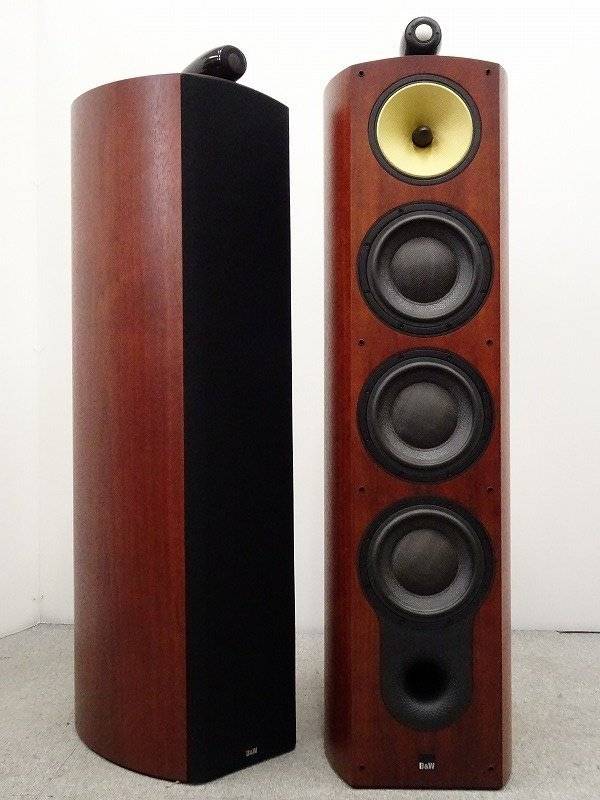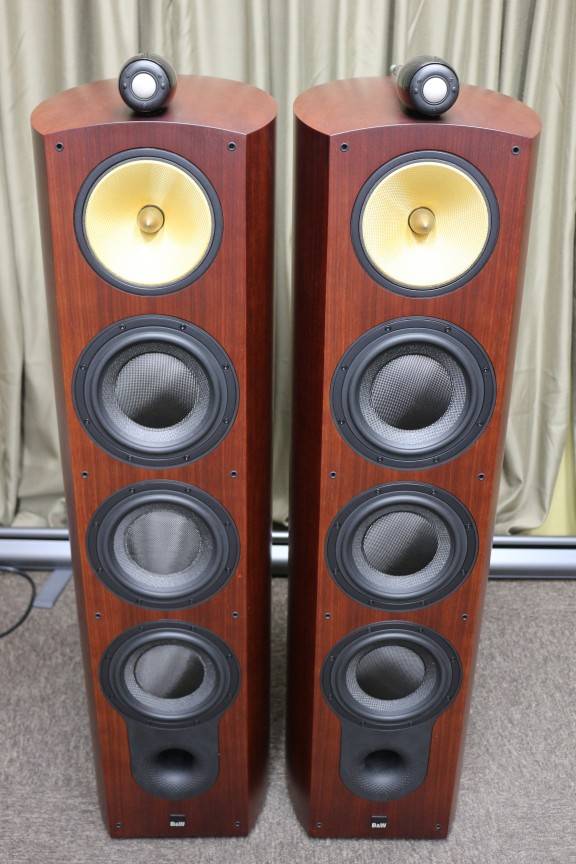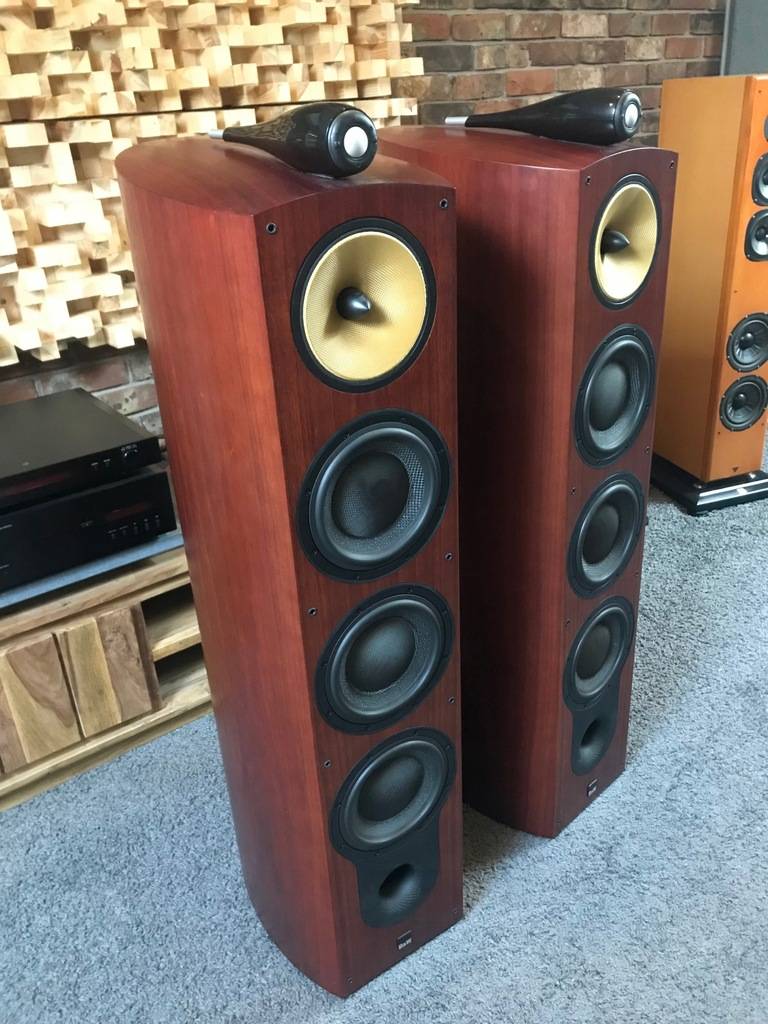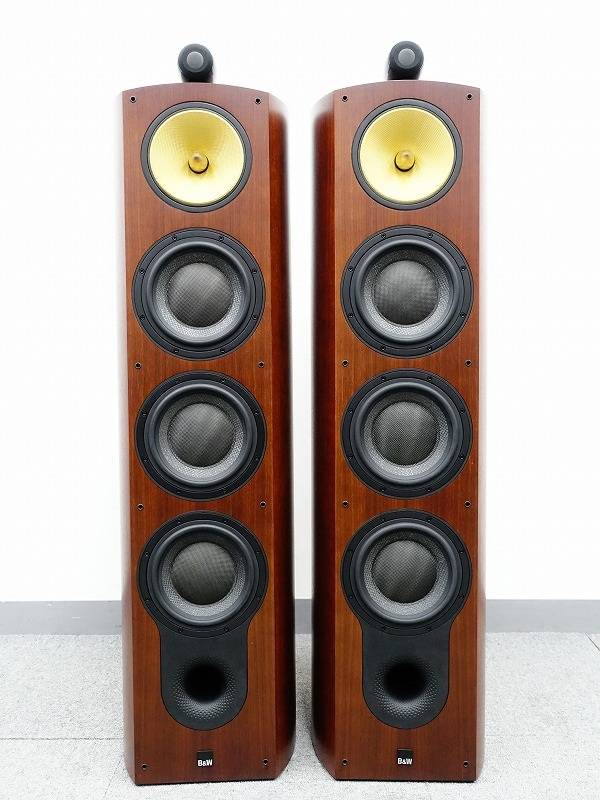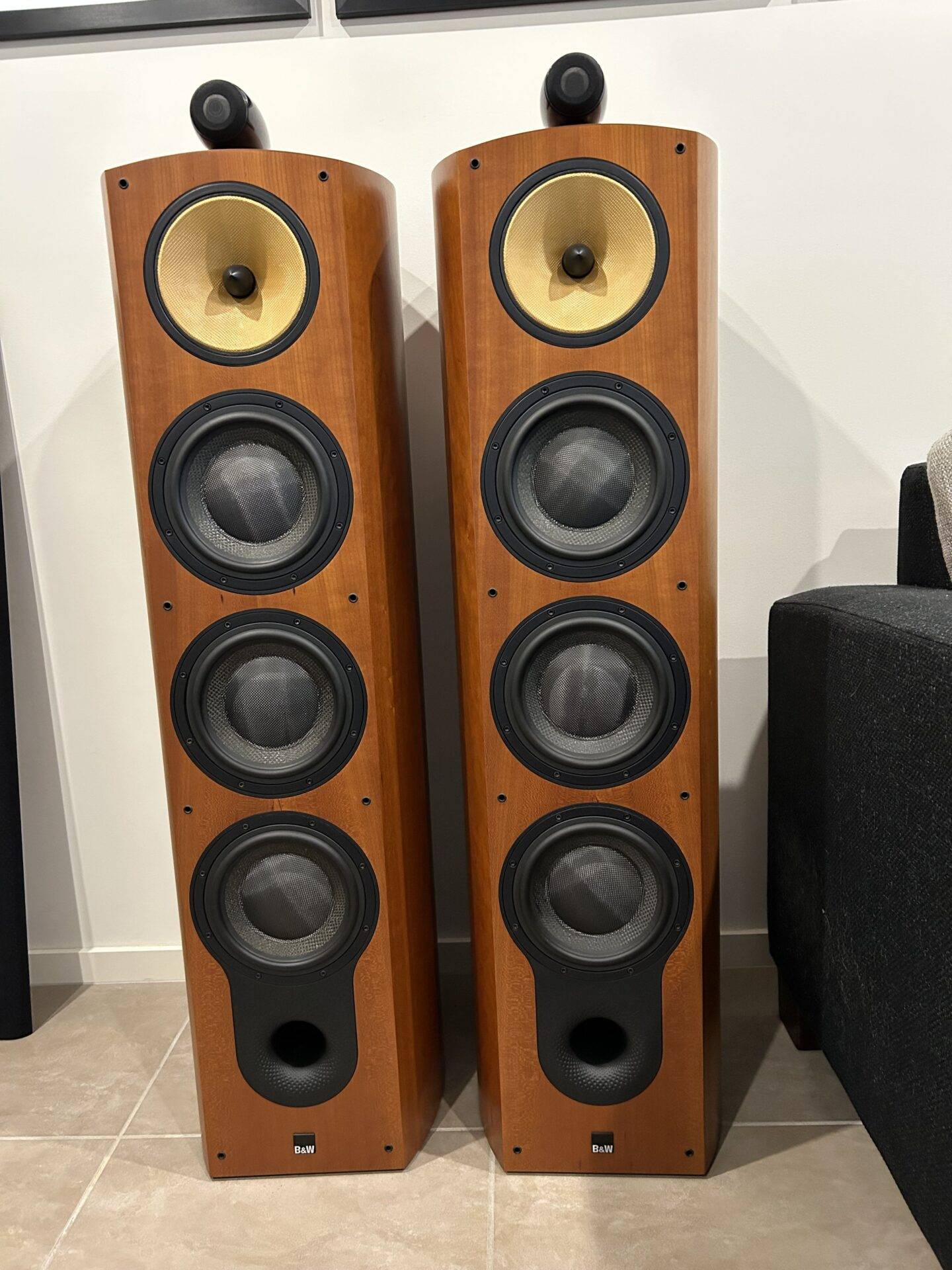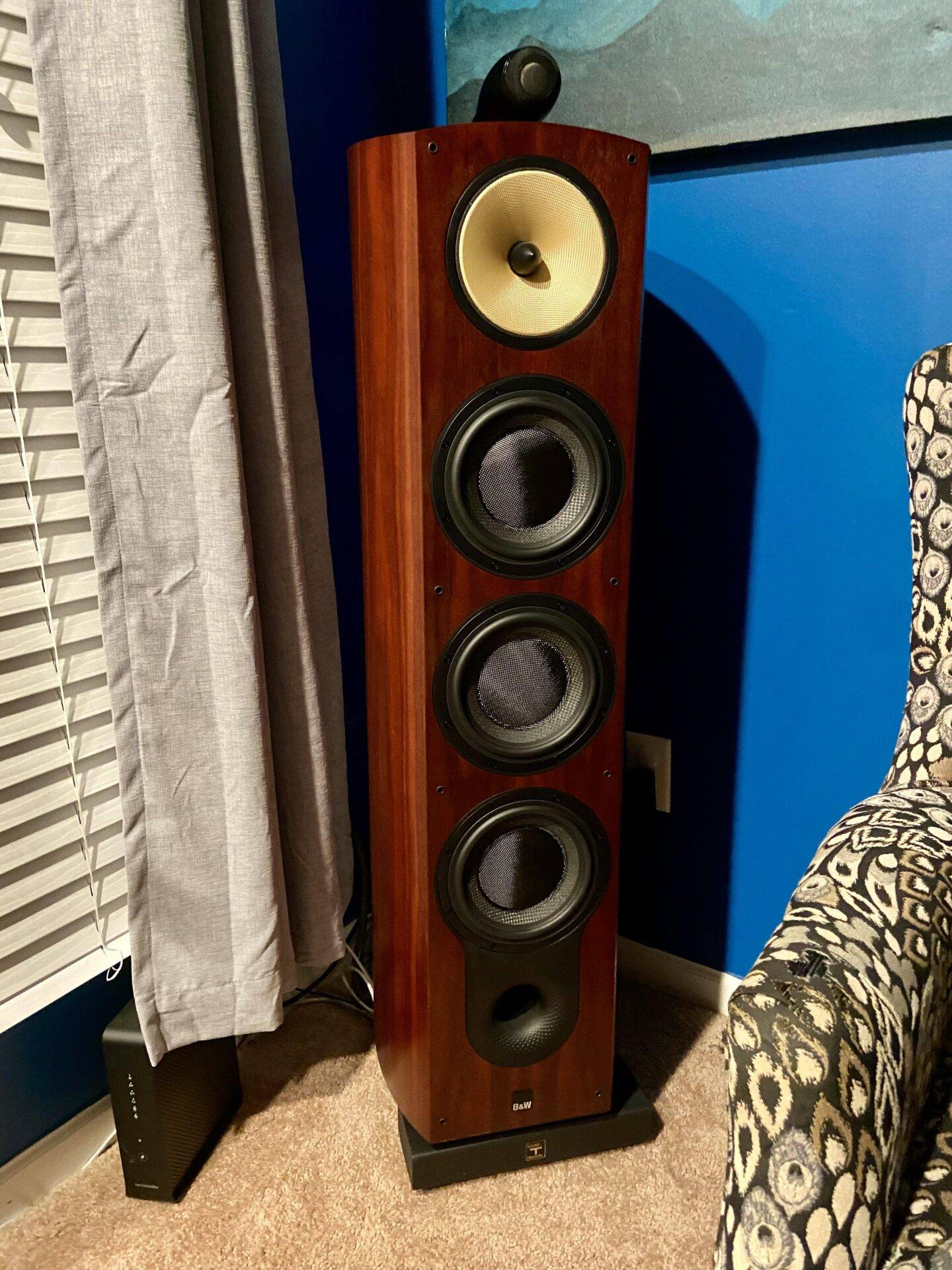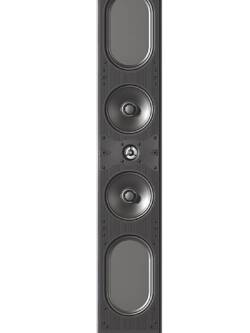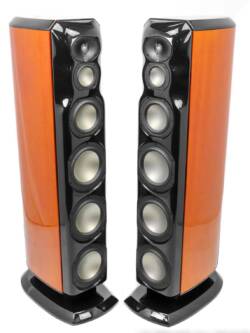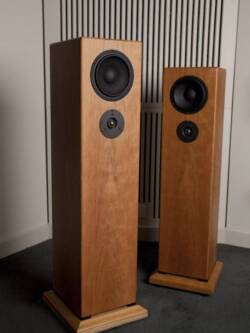B&W 803D speakers (Rosenut)
Original price was: R210,000.00.R90,000.00Current price is: R90,000.00.
Speaker: 803D
Type: Three-way tower
Tweeter (size in inches, type): 1, diamond dome
Midrange (size in inches, type): 6, Kevlar
Woofer (size in inches, type): 7 (3), Rohacell
Nominal Impedance (ohms): 8
Recommended Amp Power (watts): 50–500
Available Finishes: Cherrywood, Rosenut, Black Ash
Dimensions (H x W x D, inches): 45.8 x 12 x 18
Weight (pounds): 98
Price: $8,000/pair
Description
Diamonds can be everyone’s best friend.
If truth be told, I have little use for diamonds in their conventional form. This probably stems from all the pomp and pageantry that surrounds them—not to mention my disdain for those people who drape themselves in the stones and attempt to outshine everyone else with their brilliance. This hardly means that I have little respect for diamonds, though, even if this respect is far more about material than materialism. Since ancient times, mankind has recognized the value of the diamond for pragmatic applications, in everything from grinding and engraving tools, to drill bits, to turntable styli and semiconductors.
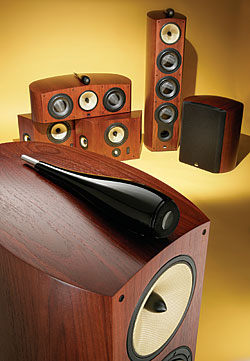 B&W has a long history of putting various materials to excellent use, so it should come as no surprise that they are breaking ground in adding tweeters to the long list of items that benefit from diamond construction. Their goal with the diamond tweeters that adorn several models in their high-end 800 Series is to continue to push the breakup frequency—the point at which the driver no longer operates as a piston and begins to introduce major colorations—higher and higher. Studies show that diamond’s first breakup frequency in this application is as high as 80.8 kilohertz—roughly three times that of aluminum. Granted, human hearing tops out at around 20 kHz, but there is substantial evidence to show that the range we do hear is powerfully affected by what’s going on in the range we don’t hear. The emergence of high-resolution audio has only increased the need for tweeters that can hold form at higher frequencies.
B&W has a long history of putting various materials to excellent use, so it should come as no surprise that they are breaking ground in adding tweeters to the long list of items that benefit from diamond construction. Their goal with the diamond tweeters that adorn several models in their high-end 800 Series is to continue to push the breakup frequency—the point at which the driver no longer operates as a piston and begins to introduce major colorations—higher and higher. Studies show that diamond’s first breakup frequency in this application is as high as 80.8 kilohertz—roughly three times that of aluminum. Granted, human hearing tops out at around 20 kHz, but there is substantial evidence to show that the range we do hear is powerfully affected by what’s going on in the range we don’t hear. The emergence of high-resolution audio has only increased the need for tweeters that can hold form at higher frequencies.
The 800 Series isn’t all about diamond tweeters, though. These models also benefit from B&W’s FST midrange driver, a Kevlar construction that is very successful at blending stiffness and rigidity with a high inherent damping factor. There’s also the Rohacell bass driver, which sandwiches an 8-millimeter piece of polymethacrylimide (i.e., hard-foam) material between two layers of carbon fiber for a beneficial blend of weight and mechanical properties with heat resistance. And, of course, there’s the famous B&W cabinets, usually topped off by the distinctive, separate tweeter (and, occasionally, separate midrange) housing. This design does have important practical purposes, such as reducing cabinet diffraction and time smearing, in addition to giving many B&W speakers their unique look.
My review system was anchored by the new 803D tower, a model that is three short steps down from the top of the 800 Series. It uses a 1-inch diamond dome tweeter, a 6-inch FST midrange unit, and three 7-inch Rohacell bass drivers in a three-way, vented-box system with a front-firing port. Extensive bracing and driver isolation are just some of these speaker cabinets’ internal perks, and the new external design is as acoustically beneficial as it is attractive. Two pairs of top-quality binding posts allow for biwiring/biamping.
Manning the center was the HTM2D, which uses the same tweeter and midrange drivers as the 803D, flanked by two of the same 7-inch woofers. This is also a vented, three-way design, although it uses two rear-firing ports. This cabinet is impressive in its internal and external design, as well, and it’s magnetically shielded for placement near a CRT-based video monitor. Two pairs of binding posts make this unit biwireable/ biampable, too.
Two DS8S speakers handled the surround channels. The DS8S is a switchable monopole/dipole design that uses a 7-inch Kevlar midbass driver mounted above a 1-inch aluminum dome tweeter on the front baffle. A 4-inch Kevlar midrange is mounted above a 1-inch aluminum tweeter on each of the side baffles. It’s a two-way system when it acts as a monopole. In its dipole mode, it’s a three-way system; the front tweeter turns off, and the front driver acts as the woofer. Keyhole mounts on the DS8S’s rear panel make for easy wall mounting.
Rounding out my system was the ASW825 subwoofer, a sealed design that uses a 12-inch Rohacell woofer and no less than 1,000 rated watts of amplification. Thanks in part to its use of switched-mode power supplies, it remains relatively small and light despite its impressive internal power. The rear panel offers line-level inputs and outputs, phase, gain, and crossover controls, and crossover bypass.
Top-shelf speakers need top-shelf electronics, so I set up the B&W system with a variety of amplifiers, including a Lexicon LX-7, a Simaudio MOON Titan, and even my old Aragon Palladium monoblocks. A Lexicon MC-12 served as the primary pre/pro, and the Simaudio MOON Orbiter universal player spun the source material. I set the front speakers a couple of feet from the side and rear walls and toed them in slightly; I mounted the center channel near ear level below a projection screen; and I placed the surround channels 120 degrees from the listening position, about 1 foot above ear level in the seated position.
Right out of the gate, with two-channel music, the 803Ds grabbed me with a deep, wide soundstage and excellent imaging. Vocals that were recorded to be in the dead center were reproduced in the dead center. If they were meant to be off to one side or the other, they were. Guitars, drums, harmonicas, banjos—you name it, and the 803Ds will place it right where the musicians and, ultimately, the engineers intended it to be placed. One of the most impressive displays of staging was with “Katy Hill” from the CD The Three Pickers, a track that captures some 25 instruments on stage at the same time, including multiple guitars, fiddles, and banjos. Having seen the DVD rendition of this concert many times, I know exactly where everyone is supposed to be, and that’s right where they were when I listened to the CD through the 803Ds. The speakers also did a fantastic job of separating each individual fiddle, guitar, or banjo, even if they were playing the same part.
I suspect many of you want to know if the diamond tweeter lives up to its hype in the listening room. It does, indeed. Anyone concerned about diamond’s potential for considerable mass will find no evidence of it here. This tweeter is as agile and pure-sounding as any I’ve ever heard, no matter what material I gave it. Cymbals were crisp and clean, with no sibilance or overhang. Benny Goodman’s clarinet was as natural as the recording would allow it to be. And Little Walter’s harmonica had an attack and immediacy that can only have been just short of hearing it live.
The B&W system saved its most impressive musical output for high-resolution material, though. It was here that, with properly engineered material, the speakers absolutely disappeared, and all that was left was music in a natural and effortless state. I could ramble on about how impressively the system reproduced each individual frequency range, but the ultimate goal of each speaker is to operate as its own subsystem, reproducing the entire spectrum (or at least as much of it as it’s designed to) successfully and without holes. I already knew the 803Ds could do this, but I quickly learned that the HTM2D, and even the DS8Ss, could too, and this made for an unforgettable 5.1-channel musical experience. This material didn’t tax the ASW825 much, but the sub made the most of its opportunity and proved that movies aren’t the only thing it’s comfortable with.
Speaking of movies, the disappearing act continued with soundtrack reproduction—and that made for an intense and electrifying experience with scenes like the Omaha Beach assault from Saving Private Ryan or Gandalf’s fiery descent with the Balrog from LOTR: The Two Towers. I found myself entirely caught up in the experiences, and, at times, I forgot my critical role and simply reveled in running my all-time-favorite movie scenes through this system for pure enjoyment. I kept my head about me enough to note that all the critical soundtrack elements were here: clean, uncluttered dialogue, an entirely cohesive and deep surround soundfield, and forceful, penetrating bass that only overwhelmed when it was supposed to. The HTM2 is as strong a center channel as you’ll find anywhere. It relishes in the challenges that modern soundtracks present to this channel and simply refuses to be overwhelmed. Its effortlessness is one of its most endearing qualities—and I could say the same about this system as a whole. If you can’t get lost in this system and forget you’re listening to speakers, there may be no hope left for you.
I fully admit to having considerably high expectations when I see the B&W logo on the front of a speaker. All the talk about the diamond tweeter that I had heard prior to this review, along with what I already know about B&W’s midranges, woofers, and cabinets, only increased my expectations. This system not only met those expectations; it exceeded them—and memorably so, at that. These speakers are a prime example of the successful manifestation of build and design principle into sonic reality in the listening room. But the pure enjoyment and excitement that this system delivered is probably the ultimate compliment I can pay it. This B&W system was as enveloping, exhilarating, and flat-out enjoyable as any speaker system I’ve ever heard.
Highlights
• World-class sound with music and movies
• Pure enjoyment and excitement factor
The Bowers & Wilkins 803 Diamond loudspeaker is the middle model in the company’s current flagship line. Below it are the 805 Diamond bookshelf ($5000 USD/pair) and the smaller floorstander, the 804 Diamond ($7500/pair). Above it are the 802 Diamond ($15,000/pair) and the 800 Diamond ($24,000/pair), both distinguished by the spherical midrange-driver enclosures of Marlan that sit atop the bass cabinets.
When the Diamond range, which replaces the 800D series, was announced about a year ago, it was the 803 Diamond that captured my attention. First, the price is $10,000/pair. My experience has taught me that $10k is the threshold for what even many audio enthusiasts consider downright expensive for a pair of speakers. However, we live in a time when speakers costing over $100,000/pair are not uncommon, and $500 can buy you a very decent set of bookshelf speakers. To my mind, $10,000 should get you a whole lot closer to the performance of $100,000 speakers than merely a step or two above the $500 models.
I was also taken with the 803 Diamond’s appearance, which to me is far more attractive than those of its dearer relatives, the 800 and 802. The 803’s simpler cabinet and cleaner lines distinguish it from the pricier models, which visually scream High-tech speaker! The 803 Diamond will fit into listening spaces that, domestically speaking, could not easily accept the larger models.
But more important, the 803 Diamond includes much of the technology of B&W’s more expensive Diamonds.
Technology
The 803 Diamond’s most prominent design feature — and the one most visitors to my listening room commented on first — is the Nautilus Tapering Tube (NTT) that sits atop its cabinet. This oblong enclosure houses the latest iteration of B&W’s 1″ diamond tweeter, features that are common to all the speakers in the line. The new tweeter employs a quad-magnet-powered voice-coil and a new surround material, among other improvements on the 800D models. The NTT driver-loading method is designed to dissipate the tweeter’s backwave — the soundwaves generated by the rearward motion of the tweeter diaphragm, which can negatively affect the direct response of the driver if not somehow suppressed or absorbed. The NTT is filled with damping material and acts as a black hole for sound. Those highs simply are not reflected back out the front to your ears.
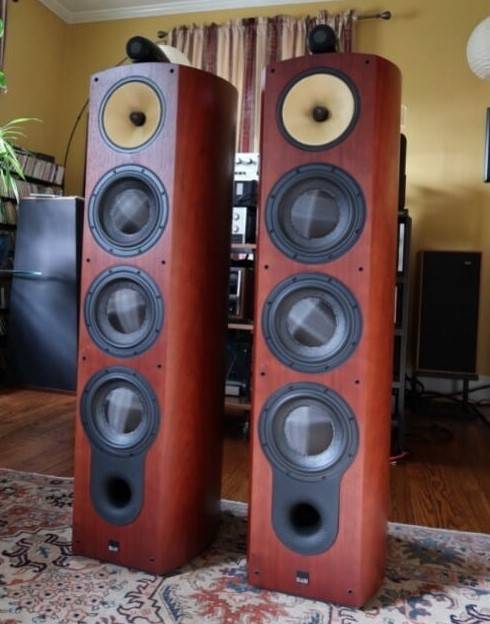 The other obvious design feature that stands out is the 6″ yellow Kevlar midrange driver, in this case a special version developed by B&W called a Fixed Suspension Transducer (FST). This unit is unique in the world of speaker drive-units in not having a conventional surround (the ring of rubber or foam that links cone to basket and lets the driver cone travel back and forth). In fact, B&W calls the FST “surroundless,” because it terminates in the same material of which the cone proper is made: Kevlar. There is a foam ring, however; it sits directly under the termination point of the cone to the basket and absorbs resonances transmitted by the cone — a task normally accomplished by a drive-unit’s surround. One problem this method solves that B&W thinks is critical are the acoustic cancellations caused by the surround. They state that the cancellation issue “involves the cone moving more than it should in one direction, while the surround moves in the opposite direction. Whether this results in a dip, peak or no change in the amplitude response depends on the relative area velocity of the cone and surround, but more often than not it is a dip, often referred to as the surround dip. These standing-wave patterns can be modified if attention is paid to the mechanical impedance of both the surround and the voice coil. If these can be matched to the mean mechanical impedance of the outer rim and neck of the cone respectively, bending wave reflections can be reduced in magnitude, with a consequent reduction in the level of delayed energy coloration.” B&W says that since cone excursions are small in the frequency band in which this driver operates, this termination method yields better sound than would a conventional surround.
The other obvious design feature that stands out is the 6″ yellow Kevlar midrange driver, in this case a special version developed by B&W called a Fixed Suspension Transducer (FST). This unit is unique in the world of speaker drive-units in not having a conventional surround (the ring of rubber or foam that links cone to basket and lets the driver cone travel back and forth). In fact, B&W calls the FST “surroundless,” because it terminates in the same material of which the cone proper is made: Kevlar. There is a foam ring, however; it sits directly under the termination point of the cone to the basket and absorbs resonances transmitted by the cone — a task normally accomplished by a drive-unit’s surround. One problem this method solves that B&W thinks is critical are the acoustic cancellations caused by the surround. They state that the cancellation issue “involves the cone moving more than it should in one direction, while the surround moves in the opposite direction. Whether this results in a dip, peak or no change in the amplitude response depends on the relative area velocity of the cone and surround, but more often than not it is a dip, often referred to as the surround dip. These standing-wave patterns can be modified if attention is paid to the mechanical impedance of both the surround and the voice coil. If these can be matched to the mean mechanical impedance of the outer rim and neck of the cone respectively, bending wave reflections can be reduced in magnitude, with a consequent reduction in the level of delayed energy coloration.” B&W says that since cone excursions are small in the frequency band in which this driver operates, this termination method yields better sound than would a conventional surround.
The 90-pound weight of the 803 Diamond gives some clue that there’s more in the box than might be indicated by its not-huge dimensions of 45.8″H x 12″W x 18″D. Inside is the Matrix — a network of horizontal and vertical braces of MDF that has been a hallmark of B&W’s top speakers for about 20 years, and that strongly damps the cabinet while keeping its walls from flexing.
I was also captivated by the bass section of this three-way loudspeaker. Instead of the 802 Diamond’s twin 8″ woofers, the 803 Diamond has three dual-magnet 7″ Rohacell drivers. That doesn’t seem like much of a liability to me — in fact, you can argue that having three motor systems instead of two might even result in better power handling, due to the greater thermal dissipation available from three voice-coils instead of two. B&W states on their website that the 803 Diamond gives up very little in the bass range to the 802.
I prefer the look of the 803 to any other model in the Diamond range, although the 805’s near-perfect proportions come close. The painted Piano Gloss Black finish on my samples was glossy and smooth, and rivaled some of the best finishes I’ve seen, if falling short by the narrowest margin due to a slight waviness in the MDF enclosure. The black paint was virtually free of swirls, however. Rosenut and Cherrywood real-wood veneers are also available.
The front venting of the 803 Diamond is handled by a Flowport, whose dimpled surface resembles that of a golf ball. The dimples address the smooth flow of air leaving the enclosure. The Flowport is said to prevent the dreaded port chuffing at high volume levels.
The 803 Diamond’s claimed frequency responses are 35Hz-28kHz, ±3dB, and 28Hz-33kHz, -6dB. The sensitivity is listed as 90dB/W/m, the nominal impedance 8 ohms. The rated power capacity is 500W with unclipped program material. Two pairs of custom binding posts are included for biamping or biwiring, and they’re some of the best I’ve used: easy to tighten, extremely sturdy, and while they’re unknurled, I could easily get a firm grip on them to ensure a tight, secure cable connection. Jumpers are supplied for single-wiring.
Setup
I set up the 803 Diamonds in my Music Vault listening room and tried to find the best locations for them. As with all speakers I audition in this room, this involved a lot of trial and error: listening, moving, measuring the frequency response, listening some more. The 803s ended up slightly toed-in and 11’ 8″ apart (measured from tweeter to tweeter), 4’ 3″ from the front wall (from the cabinets’ rear panels), with 5’ 7″ between each speaker’s outer side panel and the corresponding sidewall. The supplied grilles attach with magnets, a nice touch seen in more and more speakers these days, but I left them off for the duration of the review period.
Sound
A loudspeaker’s overall sound is largely a function of its tonal balance — a conclusion I came to a while back, after many years of reviewing speakers. Conducting in-room measurements has taught me much, but nothing set so solidly in stone as the fact that an accurate statement of a speaker’s frequency response (FR) will tell you quite a bit about how loudspeakers will sound when you’re seated in a chair planted in front of them. The 803 Diamond had a distinctive sonic character in my room that seems to me to be a deliberate effort by B&W to follow a house sound through an expertly tailored FR. Such a design choice — a speaker’s voicing, if you like — can be a matter of taste, and in this instance I liked the results, and imagine you will, too.
When you see that diamond tweeter perched atop the 803, you might at first assume that the speaker’s highs will sonically stick out from the whole, and perhaps create a tipped-up, bright tonal balance. Like other audiophile myths — e.g., that silver cables always sound thin — having a diamond tweeter physically separated from the rest of the drive-units can be visually disconcerting, even if the sonic results are quite different. In the case of the 803 Diamond, what I heard on first listen was a high range that was just the opposite of what you might expect — it was expertly integrated into a very smooth overall sound, and didn’t stick out in any way. Forget spotlit highs or bright sound — the 803 was the antithesis of all that. I won’t say that the highs were actually subdued — there were still goodly amounts of detail, sparkle, and life — but the upper frequencies were neatly tucked into the overall sound and never called attention to themselves.
Listening to Carla Lother sing “Let’s Grow Old,” from her 100 Lovers (24/96 AIFF, Chesky/HDtracks), accompanied by acoustic guitar, gave clear evidence of this. There was detail aplenty in the strings, but this detail never sounded like a hyped-up addition to the recording. The sound of Lother’s voice, on down to the percussion, was continuous and smooth and, again, well integrated into the whole without flaw. Most important, the generous highs in this hi-rez track never grated or made me want to turn down the volume.
The above description gives you a hint of the rest of the picture. Yes, the 803 Diamond had a full, slightly rich tonal balance. The midrange was clean and clear — I heard nothing that obscured the middle frequencies — and because of this I heard very deep into vocal recordings. But there was enough body in male voices, for instance, to make the 803 a captivating listen with music of many types. This full tonal balance added a touch of presence and, in some cases, drama. I enjoyed recordings such as Livingston Taylor’s cover of Stevie Wonder’s “Isn’t She Lovely,” from Ink (24/96 AIFF, Chesky/HDtracks), because of how the 803 clearly revealed the nuance and expression in Taylor’s singing. His whistling at the start was every bit as detailed and clean as the beryllium tweeter I heard in PBN Audio’s Montana Sammy loudspeaker ($29,500/pair, reviewed on Ultra Audio in October of 2010), though the 803’s highs were a bit lower in level in absolute terms (and certainly lower in level than the KEF Reference 205/2, which Randall Smith reviewed for SoundStage! Hi-Fi in September 2010). The lower midrange was a touch more forward than the slightly recessed mids of the PBN. This gave greater presence to Taylor’s voice, making him sound very in-the-room close to my listening position. I could hear the detail and texture in his singing, and a hint of warmth that translated into extra-beautiful tone color.
The bass range was almost everything I’d hoped for. The 803 was abundant in most of the bass qualities I look for: great punch, check; excellent articulation, yes; good weight down low, yessiree. But the 803 couldn’t play quite low enough to be a world beater. Were my expectations too high? Maybe, but when I listened to my go-to track for bass depth and power, “Norbu,” from Bruno Coulais’s soundtrack for Himalaya (CD, Virgin 8 48478 2), the 803s didn’t quite fully energize my room. They came so close, though. I could clearly hear and feel the whack of mallet on drum skin — a nimble display of finesse and articulation on the 803’s part. I could feel the walls of my listening room start to flex, and hear and feel the decay of the big drum as it rolled right on behind me. But the last 5% — that elusive bit of low-end power that would have made the 803 Diamond a genuine giant killer — was missing. Is this a fatal flaw? Hardly. Get a subwoofer, perhaps from B&W, or from Paradigm or JL Audio, and you’re all set. The bass that the 803s did produce was hard to fault in terms of quality, that’s for sure.
The soundstaging was as wide as from any pair of speakers in recent memory. The slightly upfront nature of the 803’s lower midrange did mean that there wasn’t the soundstage depth I’ve heard with some other speakers that have a more distant midband (a recessed midrange can create more apparent depth, even if it’s artificial). The result of the presence in the midrange was that the 803s could sound very intimate, giving me great insight into the singing in many different genres of music. Jazz vocals recorded in small venues were simply breathtaking, for instance. I think folks will be satisfied with the imaging and soundstaging capabilities of the 803 Diamonds; there was accurate focus, and I could easily map the soundstage in my mind. The 803s didn’t sound ethereal or crazy-spacious, but they certainly let me know how recordings were miked and exactly where instruments were placed.
Last, the 803 Diamond seemed to reach a heightened level of liveliness when propelled by slightly more power than I use with most speakers. They sounded fine at low levels, mind you, but they sounded most alive — the elusive “jump factor” that audiophiles speak of — when my Boulder amplifier was asked to feed them more watts. The takeaway: To hear all that the 803 Diamond can do, make sure you have a powerful amplifier of at least a couple hundred watts.
The 803 could also play plenty loud. Perhaps this quality was born of the ubiquity of B&W speakers in recording studios across the world, where output capability without damage really matters. I didn’t try to actually destroy the 803s, but I did give them a pretty good beating. They never flinched.

Polished
Bowers & Wilkins has crafted a fine loudspeaker in the 803 Diamond. It leans slightly toward the warm side of the audioband — it never approached cool or lean — a characteristic that will make it sound good to most listeners. It never grated or fatigued, and the integration of B&W’s hallmark diamond tweeter was deftly accomplished. Its bass was satisfying in terms of quality and, in terms of quantity, ever so close to forget-the-subwoofer territory. It will give you most everything you need in the lows, but I’m a big-speaker guy, so perhaps my wants in this area are more extreme than most. Still, I know of many speakers costing over $10k, and some well over, that won’t do low bass like the 803.
When you plunk down your ten grand for a pair of 803 Diamonds, you get something more than really good sound. You get to own a B&W — a speaker with a lineage as impressive as any brand’s. This is a wholly finished product that will not disappoint in any part of the ownership experience, and I can’t say that of everything in the high end. If you’re looking at speakers for over $10,000 and they aren’t better than the 803 Diamond, then they just aren’t competitive high-end speakers. Listen to it and do the comparisons — the wide availability of the brand ensures that you’ll have reasonable access. I’m quite sure that the 803 Diamonds will find homes in many fine music systems across the world, and rightly so.
